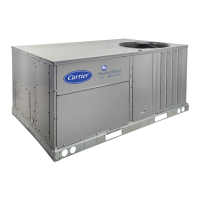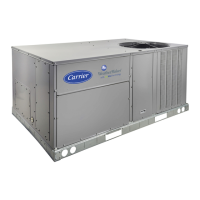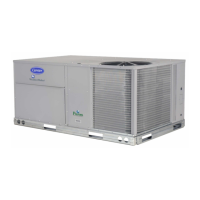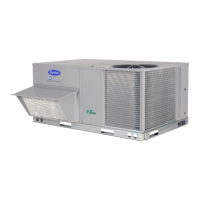ITEM
COOL
C.CAP
CUR.S
REQ.S
MAX.S
DEM.L
SUMZ
SMZ
ADD.R
SUB.R
R.PCT
Y.MIN
ZPLU
ZMIN
ZPLU
H.TMP
L. TMP
PULL
SLOW
Table 62 -- Run Status Cool Display
EXPANSION
COOLING INFORMATION
Current Running Capacity
Current Cool Stage
Requested Cool Stage
Maximum Cool Stages
Active Demand Limit
COOL CAR STAGE CONTROL
Capacity Load Factor
1 RANGE .I, UNITS [ CCNPOINT J WRITE STATUS
-1O0 - +1O0
%
%
CAPTOTAL
COOL STG
CL ST-AGE
CL_IAXSTG
DEM_LIM
SMZ
forcible
Next Stage EDT Decrease
Next Stage EDT Increase
Rise Per Percent Capacity
Cap Deadband Subtracting
Cap Deadband Adding
Cap Threshold Subtracting
Cap Threshold Adding
High Temp Cap Override
Low Temp Cap Override
Pull Down Cap Override
Slow Change Cap Override
^F ADDRISE
^F SUBRISE
RISE PCT
Y MI_IUS
YPLUS
ZMINUS
Z PLUS
HI-TEMP
LOW TEMP
PULL-DOWN
SLO CHNG
Slow Change Cap Override (SLOW) -- With a rooftop unit,
the design rise at 100% total unit capacity is generally around
30 ° F. For a unit with 4 stages, each stage represents about
7.5 ° F of change to EDT. If stages could reliably be cycled at
very fast rates, the set point could be maintained very precisely.
Since it is not desirable to cycle compressors more than 6 cy-
cles per hour, slow change ovemde takes care of keeping the
PID under control when "relatively" close to set point.
SumZ Operation -- The SumZ algorithin is an adaptive PID
style of control. The PID is progralmned within the control and
the relative speed of staging can only be influenced by the user
through the adjustment of the Z GN configuration. The capaci-
ty control algorithin uses a modified PID algorithin, with a self
adjusting gain which compensates for varying conditions, in-
cluding changing flow rates across the evaporator coil.
Previous hnplementations of SumZ made static assump-
tions about the actual size of the next capacity jump up or
down. This control uses a "rise per percent capacity" technique
in the calculation of SumZ, instead of the previous "rise per
stage" method. For each jump, up or down in capacity, the
control will know beforehand the exact capacity change
brought on. Better overall staging control can be realized with
this technique.
SUM Calculation -- The PID calculation of the "SUM" is
evaluated once every 80 seconds.
SUM = Error + "SUM last thne through" + (3 * Error Rate)
Where:
SUM = the PID calculation, Error = EDT - Cooling Control
Point, Error Rate = Error- "Error last time through"
NOTE: "Error" is limited to between-50 and +50 and "Error
rate" is limited to between -20 and +20.
This "SUM" will be compared against the "Z" calculations
in determining whether cooling stages should be added or
subtracted.
Z Calculation -- For the "Z" calculation, the control attempts
to determine the entering and the leaving-air temperature of the
evaporator coil and based upon the difference between the two
during mechanical cooling, and then determines whether to
add or subtract a stage of cooling. This is the adaptive element.
The entering-air temperature is referred to as MAT
(mixed-air temperature) and the leaving-air temperature of the
evaporator coil is referred to as EDT (evaporator discharge
temperature). They are found at the local display under the
Temperatures _C'TRL sub-menu.
The main elements to be calculated and used in the calcula-
tion of SumZ are:
1) the rise per percent capacity (R.PCT)
2) the amount of expected rise for the next cooling stage
addition
3) the amount of expected rise for the next cooling stage
subtraction
The calculation of"Z" requires two variables, ZPL U used
when adding a stage and Z.MINused when subtracting a stage.
They are calculated with the following formulas:
Z.PLU= Z GN * (10 + (4*(-ADD.R))) * 0.6
Z.MIN= Z GN * (-10 + (4*(-SUB.R))) * 0.6
Where:
Z.GN = configuration used to modify the threshold levels used
for staging ( Configuration-gC OOL -gZ GN)
ADD.R = R.PCT * (C CAP - capacity after adding a cooling
stage)
SUB.R = R.PCT * (C CAP- capacity after subtracting a cool-
ing stage)
Both of these terms, Z.PLUand Z.MIN, represent a thresh-
old both positive and negative upon which the "SUM"
calculation must build up to in order to cause the compressor to
stage up or down.
(_mparing SUM and Z -- The "SUM" calculation is com-
pared against ZPL U and Z.MIN.
• If"SUM" rises above Z.PLU, a cooling stage is added.
• If"SUM" falls belowZ.MIN, a cooling stage is subtracted.
There is a variable called SMZ which is described in the
reference section and which can shnplify the task of watching
the demand build up or down over time. It is calculated as
follows:
If SUM is positive: SMZ = 100*(SUM!ZPLU)
If SUM is negative: SMZ = - 100 *(SUM!ZMIN)
Mixed Air Temperature Calculation (MAT) -- The mixed-
air temperature is calculated and is a function of the economiz-
er position. Additionally there are some calculations in the con-
trol which can zero in over time on the relationship of return
and outside air as a function of economizer position. There are
two configurations which relate to the calculation of "MAT."
These configurations can be located at the local display under
Configuration -gUNIT.
ITEM
UNIT
MAZS
MAZR
CON
I
EXPANSION RANGE POINT I DEFAULTS
I
UNIT CONFIGURATION
MAT Calc Config 0 - 2 MAT SEL Nlo
Reset MAT Table Yes/No MATRESET
Entr es?
47

